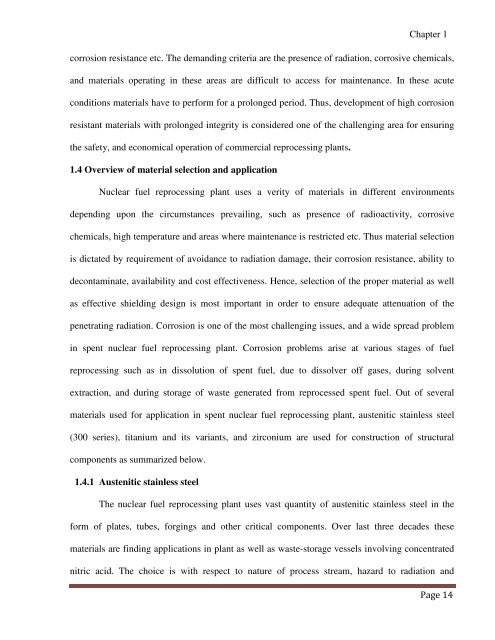CHEM02200704003 Nilamadhab Pandhy - Homi Bhabha National ...
CHEM02200704003 Nilamadhab Pandhy - Homi Bhabha National ...
CHEM02200704003 Nilamadhab Pandhy - Homi Bhabha National ...
You also want an ePaper? Increase the reach of your titles
YUMPU automatically turns print PDFs into web optimized ePapers that Google loves.
Chapter 1<br />
corrosion resistance etc. The demanding criteria are the presence of radiation, corrosive chemicals,<br />
and materials operating in these areas are difficult to access for maintenance. In these acute<br />
conditions materials have to perform for a prolonged period. Thus, development of high corrosion<br />
resistant materials with prolonged integrity is considered one of the challenging area for ensuring<br />
the safety, and economical operation of commercial reprocessing plants.<br />
1.4 Overview of material selection and application<br />
Nuclear fuel reprocessing plant uses a verity of materials in different environments<br />
depending upon the circumstances prevailing, such as presence of radioactivity, corrosive<br />
chemicals, high temperature and areas where maintenance is restricted etc. Thus material selection<br />
is dictated by requirement of avoidance to radiation damage, their corrosion resistance, ability to<br />
decontaminate, availability and cost effectiveness. Hence, selection of the proper material as well<br />
as effective shielding design is most important in order to ensure adequate attenuation of the<br />
penetrating radiation. Corrosion is one of the most challenging issues, and a wide spread problem<br />
in spent nuclear fuel reprocessing plant. Corrosion problems arise at various stages of fuel<br />
reprocessing such as in dissolution of spent fuel, due to dissolver off gases, during solvent<br />
extraction, and during storage of waste generated from reprocessed spent fuel. Out of several<br />
materials used for application in spent nuclear fuel reprocessing plant, austenitic stainless steel<br />
(300 series), titanium and its variants, and zirconium are used for construction of structural<br />
components as summarized below.<br />
1.4.1 Austenitic stainless steel<br />
The nuclear fuel reprocessing plant uses vast quantity of austenitic stainless steel in the<br />
form of plates, tubes, forgings and other critical components. Over last three decades these<br />
materials are finding applications in plant as well as waste-storage vessels involving concentrated<br />
nitric acid. The choice is with respect to nature of process stream, hazard to radiation and
















